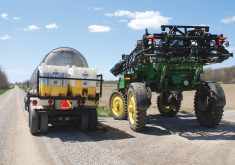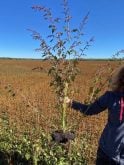Asecond glyphosate-resistant weed has been confirmed in Ontario but Manitoba farmers shouldn’t be worried.
Canada fleabane, also known as horseweed, hogweed or mare’s-tail, is not a major field crop weed in Manitoba, said Nasir Shaikh, a weed specialist with Manitoba Agriculture, Food and Rural Initiatives.
“With the kind of diverse agriculture we have, with the kind of crop rotations we have and herbicide rotation, I don’t see it developing into a glyphosateresistant weed in Manitoba,” said Shaikh.
Read Also

Canada seventh on agri-food influence
Comparison of 19 G20 countries says Canadian agri-food needs investments, processing, action on retail consolidation to realize potential
That doesn’t mean glyphosate- resistant Canada fleabane seed won’t hitch a ride here through crop seed or on equipment, he said, but the weed itself is usually only found in gravelly areas and along roadsides in this province.
The ones found in Ontario came from soybeans fields in Essex County – the same region where glyphosate-resistant giant ragweed – Canada’s first weed resistant to Roundup – was found in 2008. The discovery of the resistant fleabane was anticipated as it’s already in U.S. (and Brazilian) field crops and has also been found along rail tracks and in orchards in China, the Czech Republic and Spain.
“It is primarily a problem where growers are using no-till crop production,” said Peter Sikkema, one of University of Guelph scientists who did the research that confirmed the resistance of both weeds.
Farmers will require additional herbicides to control glyphosate-resistant Canada fleabane in their fields, including applications of Eragon and FirstRate in pre-emergent soybeans, and Eragon and Banvel II for corn. Researchers are trying to determine if there are other alternatives, including dicamba-tolerant soybeans.
North America’s first glyphosate- resistant weed, rigid rye-grass, turned up in 1998, but farmers have learned to cope with the problem, said Mark Lawton, Monsanto’s technology development lead in Eastern Canada.
“Glyphosate-resistant weeds have been effectively managed with good agronomic practices, such as using tank mixes and/ or cultural weed control methods,” Lawton said in a company press release.
Monsanto has the following advice to avoid glyphosateresistant weeds:
Start with a clean field using either a burn-down herbicide or tillage.
Use Roundup Ready technology as the foundation of a total weed-management program, but add other herbicides or cultural practices when appropriate.
Use the right herbicide at the right rate and apply at the right time.
Control weeds throughout the season to reduce the weed seed bank.
Include other crops in rotation with Roundup Ready crops so you can use other modes of action.
To assess the likelihood of glyphosate resistance developing on your farm, see www.weedtool.com. [email protected] with staff files
———
“Withthekindofdiverseagriculturewehave, withthekindofcroprotationswehaveand herbiciderotationIdon’tseeitdevelopinginto aglyphosate-resistantweedinManitoba.”
– NASIR SHAIKH















